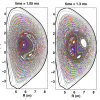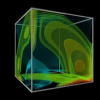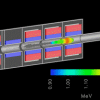Fusion Science
Fusion research at NERSC is helping to expand our fundamental understanding of plasmas - highly ionized matter at very high temperatures and densities. This will help build the scientific foundations needed to develop the predictive capability required for a sustainable fusion energy source. Specific computational goals include:
- Advancing the fundamental science of magnetically confined plasmas;
- Exploring the feasibility of the inertial confinement approach as a fusion energy source, to better understand our universe, and to enhance national security and economic competitiveness;
- Supporting the development of the scientific understanding required to design and deploy the materials needed to support a burning plasma environment; and
- Increasing fundamental understanding of basic plasma science, to enhance economic competiveness and to create opportunities for a broader range of science-based applications
Recent News
New IndexPage
Key Challenges: Developing accurate forecasts of the solar wind, an inherently turbulent process requiring simulation across a widely different scales of physics—from planet-size to the sub-atomic. Why it Matters: When strong magnetic storms occur on the Sun, tons of highly energetic particles are released into the solar wind. If these particles were free to hit the Earth, the radiation would cause life-threatening damage to our DNA, debilitate power grids, disrupt communications… Read More »
Rotating Plasma Finding is Key for ITER
Understanding an intrinsic rotation generation mechanism is one of the most important physics research topics for ITER.
Users have made quite a significant contribution to this subject, using NERSC resources at very large scale. Read More »
A New Class of Tokamak Nonlinear Plasma Instability
Many believe that the tokamak is the best candidate for producing controlled thermonuclear fusion power. Read More »
Magnetic Reconection
Projects in this area study mechanisms by which magnetic fields in plasmas change topology
and release energy to flows and energetic particles. This process
can replace hot plasma core with cool plasma, halting fusion, and
is both mysterious and potentially destructive.
Read More »
Runaway Electron Confinement Modeling
Runaway electron confinement must be understood so that ITER discharges can be shut down rapidly without damaging in-vessel components. However, ITER simulation is computationally more intensive than similar simulations of existing tokamaks. Read More »
Computational Atomic Physics for Fusion Energy
There is an urgent need for reliable atomic data to help make the choice of materials for the active plasma-facing walls in future controlled fusion devices such as ITER. Massively parallel computer architectures such as those at NERSC now play a vital role in these enormously challenging computational tasks. Read More »
Heavy-Ion Fusion Science (HIFS)
NERSC simulations were vital in making the NDCX-II experiments a success, helping to pave the way towards making inertial fusion energy an affordable and environmentally attractive means of producing commercial electricity. Read More »
Predicting Materials Performance in extreme Fusion Environments
Harnessing nuclear fusion as a commercially viable energy technology requires advances in materials science because of the enormous heat, radiation, gas formation, and corrosive interactions that will occur in the plasma-facing portions of fusion reactors. Read More »














